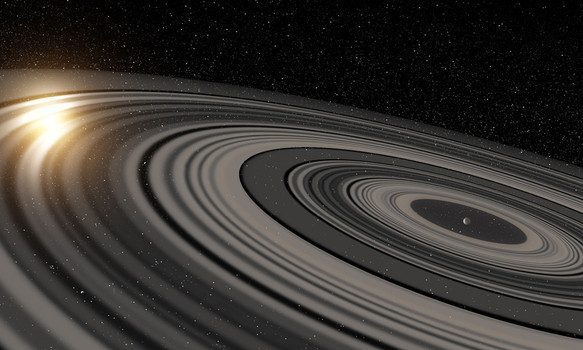Astronomers this week announced yet another mind-boggling finding: a ring system which orbits a distant giant planet has been found to be much larger and more massive than Saturn’s ring system, the best known example in our own Solar System. There may also be exomoons hiding within it. The findings come from astronomers at the University of Rochester in the U.S. and Leiden Observatory in The Netherlands.
The rings were observed eclipsing the young Sun-like star J1407, about 430 light-years away. The planet itself, J1407b, is much larger than Saturn (estimated to be 10-40 times the mass of Jupiter), and the ring system is indeed huge, about 200 times larger in size than Saturn’s rings. As co-author Eric Mamajek, professor of physics and astronomy at the University of Rochester, stated, “You could think of it as kind of a super Saturn.” The planet orbits its star in about a decade.
Matthew Kenworthy of Leiden Observatory further explained:
“The details that we see in the light curve are incredible. The eclipse lasted for several weeks, but you see rapid changes on time scales of tens of minutes as a result of fine structures in the rings. The star is much too far away to observe the rings directly, but we could make a detailed model based on the rapid brightness variations in the star light passing through the ring system. If we could replace Saturn’s rings with the rings around J1407b, they would be easily visible at night and be many times larger than the full moon.”
The discovery is based on new analysis of the data about J1407b; the ring system was first seen in 2012, but now the new information has shown astronomers just how large it really is. The system contains over 30 known rings, each of them tens of millions of miles in diameter, and the overall diameter is about 74 million miles (120 million kilometers). It is also calculated to contain approximately an Earth’s worth of mass in dust particles. To get a better sense of the amount of ring material, Mamajek put it this way:
“If you were to grind up the four large Galilean moons of Jupiter into dust and ice and spread out the material over their orbits in a ring around Jupiter, the ring would be so opaque to light that a distant observer that saw the ring pass in front of the Sun would see a very deep, multi-day eclipse. In the case of J1407, we see the rings blocking as much as 95 percent of the light of this young Sun-like star for days, so there is a lot of material there that could then form satellites.”
Apart from the rings themselves, there may also be some of the first evidence for exomoons. Gaps in the rings are thought to be regions where moons have formed or are still forming. At least one of them may be quite large, more planet-sized than typical moons:
“One obvious explanation is that a satellite formed and carved out this gap,” said Kenworthy. “The mass of the satellite could be between that of Earth and Mars. The satellite would have an orbital period of approximately two years around J1407b.”
Similar but smaller “shepherd moons” can also be seen in the rings of Saturn, Jupiter, and Uranus, where some of them clear narrow paths within some of the main rings, while others orbit near the outer edges of rings.
The data was obtained from the SuperWasp project, which detects gas giant exoplanets as they transit in front of their stars. When first found in 2012, astronomers theorized that the unusual eclipses were being caused by a moon-forming disk of rocky debris orbiting a young giant planet or perhaps even a brown dwarf star.
The ring system may become thinner over the next few million years and eventually disappear, as moons begin to form and sweep up material. Gas giants like Jupiter and Saturn may have also had larger ring systems like this earlier on in their histories.
“The planetary science community has theorized for decades that planets like Jupiter and Saturn would have had, at an early stage, disks around them that then led to the formation of satellites,” Mamajek explained. “However, until we discovered this object in 2012, no-one had seen such a ring system. This is the first snapshot of satellite formation on million-kilometer scales around a substellar object.”
It is hoped that amateur astronomers will help to monitor J1407, to possibly catch the next time the rings eclipse the star and also better pin down the orbital period and mass of the planet. Observations can be reported to the American Association of Variable Star Observers (AAVSO). Of course, it is also hoped that other similar ring systems will also be found. As Kenworthy noted, it “is the only feasible way we have of observing the early conditions of satellite formation for the near future. J1407’s eclipses will allow us to study the physical and chemical properties of satellite-spawning circumplanetary disks.”
The familiar beautiful rings we see around Saturn are already awe-inspiring; what would it be like to visit J1407b and its ring system which is 200 times larger? One can only imagine …















